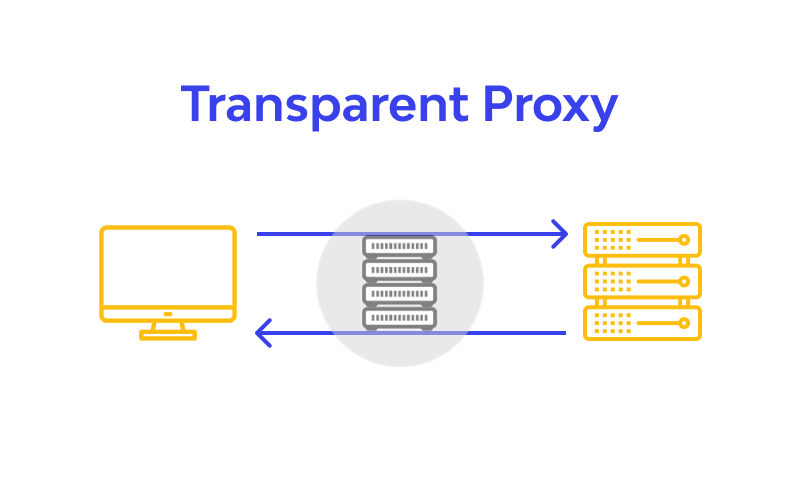What Is a Transparent Proxy? Things You Should Know

A transparent proxy serves as a go-between for users and the internet. This post will explain what a transparent proxy is, explain how it functions, go over its advantages and disadvantages, use cases, detection techniques, and how it differs from other types of proxies such web proxies, reverse proxies, non-transparent proxies, and VPNs.
What is a Transparent Proxy?
An transparent proxy, sometimes referred to as a intercepting proxy, is a kind of proxy server that manages and intercepts internet traffic without requiring any client-side settings. A transparent proxy functions at the network level, transparently rerouting client requests to the proxy server without the clients' knowledge or agreement, in contrast to other proxy kinds. Because of this, it may be used to effectively enforce network regulations, filter content, improve security, and optimise speed.
How Does a Transparent Proxy Work?
When a user sends a request to access a website or any online resource, it is intercepted by the transparent proxy server. The proxy server then evaluates the request and, based on predefined rules or policies, either allows the request to pass through or blocks it. If the request is allowed, the proxy server retrieves the requested content on behalf of the user and sends it back. From the user's perspective, the entire process is seamless and transparent.
Pros and Cons of Transparent Proxies:
Pros:
1. Enhanced Security
Transparent proxies can inspect and filter incoming and outgoing traffic, helping to protect against malware, viruses, and other cyber threats.
2. Bandwidth Optimization
By caching frequently accessed content, transparent proxies can reduce bandwidth usage and improve network performance.
3. Content Filtering
Transparent proxies can enforce content filtering policies to restrict access to certain websites or types of content.
4. Network Monitoring and Logging
Transparent proxies enable network administrators to monitor and log internet traffic, providing valuable insights and aiding in troubleshooting.

Cons:
1. Lack of User Control
As transparent proxies operate at the network level, users have limited control over their internet traffic and may not be aware of the proxy's presence.
2. Privacy Concerns
Transparent proxies can potentially intercept and log sensitive user data, raising privacy concerns.
3. Compatibility Issues
Some applications and protocols may not function properly when routed through a transparent proxy, leading to compatibility issues and service disruptions.
Use Cases for Transparent Proxy
1. Content Filtering
Transparent proxies can be used by organizations to enforce content filtering policies, blocking access to inappropriate or non-work-related websites.
2. Bandwidth Optimization
By caching frequently accessed content, transparent proxies can reduce bandwidth usage and improve network performance, especially in bandwidth-constrained environments.
3. Security and Monitoring
Transparent proxies enable network administrators to monitor and analyze internet traffic for security purposes, identifying and mitigating potential threats.

How to Detect and Bypass a Transparent Proxy?
Since a transparent proxy functions openly, identifying it might be difficult. But some indicators can point to its existence, including changed response headers or strange IP addresses in network traces. Using several proxy servers, VPNs, or encrypted protocols like HTTPS can all be used to get around a transparent.
Transparent Proxy VS Non-transparent Proxy:
A transparent proxy differs from a non-transparent proxy primarily in how visible it is to the client. While non-transparent proxies need explicit client-side setup to route traffic through the proxy server, transparent proxies function without any client-side configuration and intercept traffic effortlessly.
Transparent Proxy VS a Web Proxy:
At the network level, a transparent proxy intercepts all traffic and doesn't require client-side settings. As an alternative, users can manually set their devices to utilise a web proxy, which is a server that forwards particular online requests to.
Transparent Proxy VS Reverse Proxy:
Although they both serve as middlemen between clients and servers, transparent and reverse proxies have different main purposes. At the network level, transparent proxies intercept and manage traffic in a transparent manner, whereas reverse proxies mainly function to disperse incoming requests among several servers, hence improving security and performance.
Is VPN a Transparent Proxy?
No, A virtual private network, or VPN, is not a transparent proxy. By building a safe, encrypted tunnel between the user's device and the VPN server, a VPN (virtual private network) encrypts all data transmissions while offering users privacy and anonymity. By contrast, a transparent proxy serves as a middleman for different functions including content filtering, caching, and monitoring without encrypting communication.
Conclusion
Transparent proxies are essential for content filtering, network administration, and security enforcement. They raise worries regarding user privacy and compatibility issues, even though they provide advantages including improved security, bandwidth tuning, and content screening. Making informed judgements about internet traffic management and security measures can benefit individuals and tuning. This can be achieved by having a thorough understanding of the functions, applications, and distinctions between transparent proxies and other proxy kinds.
